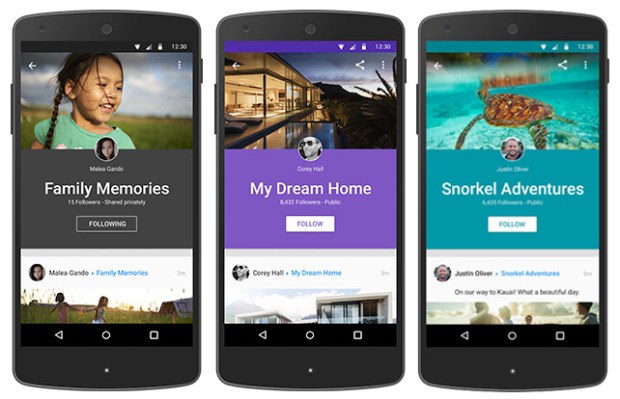Google+, the company’s social networking service that allows users to share posts and photos with family, friends and the broader public, has been sometimes criticized for being too much like competitor Facebook in terms of feature set. But today, Google+ is taking inspiration from another source: Pinterest. With the launch of a new “Collections” feature, users are now able to build content collections based on topics and interests.
These collections include a group of posts on a particular topic that can either be shared publicly, privately or with specific sets of people – similar to Google+ posts themselves.
After a user creates their first collection using the new feature, their Google+ profile will display a new tab where others can find and follow their shared collections. Posts from collections you’re following will also appear in your home stream, says Google.
The company tells us that the decision to launch Google+ Collections came from observing user behavior on the site. Users were connecting around their shared interests, and wanted a better way to organize content around those interests, too.

Before today, the ability to socialize around a given interest was somewhat addressed by the 2012 launch of Communities, which are more like a modern-day take on online forums or message boards. With Communities, an organizer could create a public, semi-public, or private space for group members to discuss a given subject.
Collections, meanwhile, are more personal. They’re built by individual users, and seem to serve more as a way for Google+ users to establish their authority on or passion for a particular subject. However, it does seem likely that there will be some overlap between the two features.
Early testers have created collections on topics like Steampunk, Make Up: How-To’s, Inspiration, Tools & Hacks, Video Games, The Fabulous Forests, Nomilicious, and more. But there are also Communities focused on many of these same topics as well.
It’s unclear to what extent offering users the ability to organize their own content into groups will actually increase user engagement with the social network, as Google+ has historically struggled to differentiate its site from Facebook over the years and grow beyond its core audience to reach mainstream saturation. That has led the company to reportedly consider splitting the network into halves – one focused on streams and another on photos.
Some independent research into Google+’s traction has also shown that the network may have around 2.2 billion profiles, but only 9 percent include public content. In addition, only 0.3 percent of all Google+ profiles, or around 6.6 million users, have made a public post in 2015. It seems that much Google+ activity is actually related to things like Google+-enabled YouTube comments, Google+ profile changes, or integrations with other Google services and not public posts directly on the destination site itself.
That indicates that there’s a smaller user base that’s actually prolific enough to be interested in organizing their posts the way Google+ Collections now allows.
The new feature is currently live on the web and on Android, with iOS support coming later.
